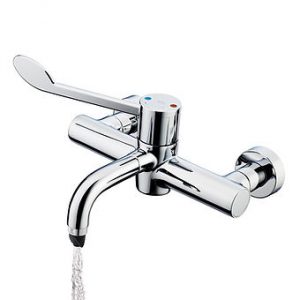Introduction: In healthcare facilities, waterborne pathogens like Pseudomonas and Legionella pose significant health risks to patients and staff. Preventing their growth and transmission is a top priority, and one effective measure is the regular flushing of water systems. In this blog, we will explore the importance of routine flushing in maintaining clean and safe water supplies. Additionally, we will share an insightful video highlighting the significance of this practice in safeguarding healthcare environments.
significant health risks to patients and staff. Preventing their growth and transmission is a top priority, and one effective measure is the regular flushing of water systems. In this blog, we will explore the importance of routine flushing in maintaining clean and safe water supplies. Additionally, we will share an insightful video highlighting the significance of this practice in safeguarding healthcare environments.
Section 1: Understanding the Threat of Pseudomonas and Legionella
Pseudomonas and Legionella are dangerous bacteria that can thrive in water systems. If left unchecked, they can lead to severe health complications, especially in immunocompromised patients. Contaminated water droplets can be inhaled, causing serious respiratory issues. By implementing appropriate preventative measures, healthcare facilities can effectively protect their occupants.

Section 2: The Role of Regular Flushing in Combating Waterborne Pathogens
Regular flushing of water systems is a crucial preventive strategy. Flushing helps to remove stagnant water and maintain proper water flow, preventing the buildup of harmful microorganisms. This process also promotes the elimination of sediments and biofilms where bacteria can flourish.
Healthcare providers should develop a comprehensive flushing schedule based on industry best practices and guidelines. A well-implemented flushing plan or implementation of the Challis Ag+ Water Management System WMS, can significantly reduce the risk of waterborne infections and enhance overall water quality.
Section 3: Video Highlight: The Impact of Regular Flushing in Healthcare Settings
Watch our recent video (link: https://youtu.be/K5O9hEaF02E?t=10) to understand the significance of regular flushing in maintaining hygienic water systems in healthcare settings. This informative video showcases real-world examples of how this simple yet effective practice can safeguard patients and healthcare workers.
 Section 4: Best Practices for Flushing Healthcare Water Systems
Section 4: Best Practices for Flushing Healthcare Water Systems
To optimize the flushing process, healthcare facilities should consider the following best practices:
-
Create a Flushing Protocol: Develop a clear and detailed flushing protocol tailored to the facility’s specific water system. This protocol should outline flushing frequency, duration, and any necessary safety precautions.
-
Train Staff: Ensure that all relevant personnel are trained on the flushing procedures and understand the importance of their role in preventing waterborne infections.
-
Monitor Water Quality: Implement regular water testing to detect any changes in water quality promptly. Monitoring helps identify potential issues before they escalate.
-
Maintenance and Upkeep: Regularly inspect and maintain the water system to address any potential problems or abnormalities.
Conclusion:
Incorporating regular flushing into healthcare water management plans is a vital step in mitigating the risk of Pseudomonas and Legionella infections. By adhering to industry best practices and guidelines, healthcare facilities can ensure the safety and well-being of their patients and staff. Don’t forget to watch our video (link: https://youtu.be/K5O9hEaF02E?t=10) for a deeper understanding of the positive impact of this preventive measure in healthcare settings. Stay vigilant, and together we can combat waterborne pathogens effectively.
